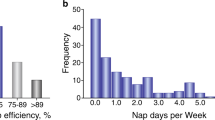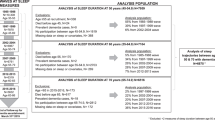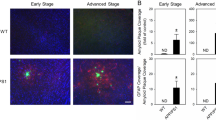Abstract
Factors other than age and genetics may increase the risk of developing Alzheimer disease (AD). Accumulation of the amyloid-β (Aβ) peptide in the brain seems to initiate a cascade of key events in the pathogenesis of AD. Moreover, evidence is emerging that the sleep–wake cycle directly influences levels of Aβ in the brain. In experimental models, sleep deprivation increases the concentration of soluble Aβ and results in chronic accumulation of Aβ, whereas sleep extension has the opposite effect. Furthermore, once Aβ accumulates, increased wakefulness and altered sleep patterns develop. Individuals with early Aβ deposition who still have normal cognitive function report sleep abnormalities, as do individuals with very mild dementia due to AD. Thus, sleep and neurodegenerative disease may influence each other in many ways that have important implications for the diagnosis and treatment of AD.
This is a preview of subscription content, access via your institution
Access options
Subscribe to this journal
Receive 12 print issues and online access
$209.00 per year
only $17.42 per issue
Buy this article
- Purchase on Springer Link
- Instant access to full article PDF
Prices may be subject to local taxes which are calculated during checkout

Similar content being viewed by others
References
Moran, M. et al. Sleep disturbance in mild to moderate Alzheimer's disease. Sleep Med. 6, 347–352 (2005).
Ancoli-Israel, S. et al. Variations in circadian rhythms of activity, sleep, and light exposure related to dementia in nursing-home patients. Sleep 20, 18–23 (1997).
Swaab, D. F., Fliers, E. & Partiman, T. S. The suprachiasmatic nucleus of the human brain in relation to sex, age and senile dementia. Brain Res. 342, 37–44 (1985).
Schneider, J. A., Arvanitakis, Z., Leurgans, S. E. & Bennett, D. A. The neuropathology of probable Alzheimer disease and mild cognitive impairment. Ann. Neurol. 66, 200–208 (2009).
Petersen, R. C. Mild cognitive impairment as a diagnostic entity. J. Intern. Med. 256, 183–194 (2004).
Westerberg, C. E. et al. Concurrent impairments in sleep and memory in amnestic mild cognitive impairment. J. Int. Neuropsychol. Soc. 18, 490–500 (2012).
Sperling, R. A. et al. Toward defining the preclinical stages of Alzheimer's disease: recommendations from the National Institute on Aging–Alzheimer's Association workgroups on diagnostic guidelines for Alzheimer's disease. Alzheimers Dement. 7, 280–292 (2011).
Ju, Y. S. et al. Sleep quality and preclinical Alzheimer disease. JAMA Neurol. 70, 587–593 (2013).
Roh, J. H. et al. Disruption of the sleep-wake cycle and diurnal fluctuation of β-amyloid in mice with Alzheimer's disease pathology. Sci. Transl. Med. 4, 150ra122 (2012).
Duncan, M. J. et al. Effects of aging and genotype on circadian rhythms, sleep, and clock gene expression in APPxPS1 knock-in mice, a model for Alzheimer's disease. Exp. Neurol. 236, 249–258 (2012).
Platt, B. et al. Abnormal cognition, sleep, EEG and brain metabolism in a novel knock-in Alzheimer mouse, PLB1. PLoS ONE 6, e27068 (2011).
Tworoger, S. S., Lee, S., Schernhammer, E. S. & Grodstein, F. The association of self-reported sleep duration, difficulty sleeping, and snoring with cognitive function in older women. Alzheimer Dis. Assoc. Disord. 20, 41–48 (2006).
Faubel, R. et al. Usual sleep duration and cognitive function in older adults in Spain. J. Sleep Res. 18, 427–435 (2009).
Blackwell, T. et al. Association of sleep characteristics and cognition in older community-dwelling men: the MrOS sleep study. Sleep 34, 1347–1356 (2011).
Potvin, O. et al. Sleep quality and 1-year incident cognitive impairment in community-dwelling older adults. Sleep 35, 491–499 (2012).
Lim, A. S. et al. Sleep fragmentation and the risk of incident Alzheimer's disease and cognitive decline in older persons. Sleep 36, 1027–1032 (2013).
Yaffe, K. et al. Sleep-disordered breathing, hypoxia, and risk of mild cognitive impairment and dementia in older women. JAMA 306, 613–619 (2011).
Kang, J.-E. et al. Amyloid-β dynamics are regulated by orexin and the sleep-wake cycle. Science 326, 1005–1007 (2009).
Huang, Y. et al. Effects of age and amyloid deposition on Aβ dynamics in the human central nervous system. Arch. Neurol. 69, 51–58 (2012).
Maquet, P. et al. Cerebral glucose utilization during sleep-wake cycle in man determined by positron emission tomography and 18F2-fluoro-2-deoxy-D-glucose method. Brain Res. 513, 136–143 (1990).
Dang-Vu, T. T. et al. Functional neuroimaging insights into the physiology of human sleep. Sleep 33, 1589–1603 (2010).
Nir, Y. et al. Regional slow waves and spindles in human sleep. Neuron 70, 153–169 (2011).
Cirrito, J. R. et al. Synaptic activity regulates interstitial fluid amyloid-beta levels in vivo. Neuron 48, 913–922 (2005).
Bero, A. W. et al. Neuronal activity regulates the regional vulnerability to amyloid-β deposition. Nat. Neurosci. 14, 750–756 (2011).
Huitrón-Reséndiz, S. et al. Age-independent and age-related deficits in visuospatial learning, sleep–wake states, thermoregulation and motor activity in PDAPP mice. Brain Res. 22, 126–137 (2002).
Jagust, W. J. & Mormino, E. C. Lifespan brain activity, β-amyloid, and Alzheimer's disease. Trends Cogn. Sci. 15, 520–526 (2011).
Horovitz, S. G. et al. Decoupling of the brain's default mode network during deep sleep. Proc. Natl Acad. Sci. USA 106, 11376–11381 (2009).
Sämann, P. G. et al. Development of the brain's default mode network from wakefulness to slow wave sleep. Cereb. Cortex 21, 2082–2093 (2011).
Mandrekar-Colucci, S., Karlo, J. C. & Landreth, G. E. Mechanisms underlying the rapid peroxisome proliferator-activated receptor-γ-mediated amyloid clearance and reversal of cognitive deficits in a murine model of Alzheimer's disease. J. Neurosci. 32, 10117–10128 (2012).
Fagan, A. M. et al. Inverse relation between in vivo amyloid imaging load and cerebrospinal fluid Aβ42 in humans. Ann. Neurol. 59, 512–519 (2006).
Farajnia, S. et al. Evidence for neuronal desynchrony in the aged suprachiasmatic nucleus clock. J. Neurosci. 32, 5891–5899 (2012).
Hastings, M. H. & Goedert, M. Circadian clocks and neurodegenerative diseases: time to aggregate? Curr. Opin. Neurobiol. 23, 880–887 (2013).
Durmer, J. S. & Dinges, D. F. Neurocognitive consequences of sleep deprivation. Semin. Neurol. 25, 117–129 (2005).
Lim, A. S. P. et al. Increased fragmentation of rest-activity patterns is associated with a characteristic pattern of cognitive impairment in older individuals. Sleep 35, 633–640B (2012).
Vahtera, J. et al. Effect of retirement on sleep disturbances: the GAZEL prospective cohort study. Sleep 32, 1459–1466 (2009).
Luik, A. I. et al. Stability and fragmentation of the activity rhythm across the sleep-wake cycle: the importance of age, lifestyle, and mental health. Chronobiol. Int. http://dx.doi.org/10.3109/07420528.2013.813528.
Alzheimer's Association. Changing the trajectory of Alzheimer's disease: a national imperative. www.alz.org[online], (2010).
Cardinali, D. P. et al. Therapeutic application of melatonin in mild cognitive impairment. Am. J. Neurodegener. Dis. 1, 280–291 (2012).
Acknowledgements
The authors' work is supported by NIH grant P01NS074969 and the Ellison Medical Foundation Senior Scholar Award (both to D. M. Holtzman). The research described in this article was made possible by a grant to Y. S. Ju from the National Center for Research Resources (UL1 RR024992), which is a component of the NIH, and the NIH Roadmap for Medical Research.
Author information
Authors and Affiliations
Contributions
All authors researched the data for the article, provided substantial contributions to discussions of its content, wrote the article and undertook review and/or editing of the manuscript before submission.
Corresponding author
Ethics declarations
Competing interests
D. M. Holtzman is a co-founder and member of the scientific advisory board of C2N Diagnostics. He also acts as a consultant for Genentech and AstraZeneca, and his laboratory receives research grants from AstraZeneca and Eli Lilly. These interests are not related to the topic of this article. The other authors declare no competing interests.
PowerPoint slides
Rights and permissions
About this article
Cite this article
Ju, YE., Lucey, B. & Holtzman, D. Sleep and Alzheimer disease pathology—a bidirectional relationship. Nat Rev Neurol 10, 115–119 (2014). https://doi.org/10.1038/nrneurol.2013.269
Published:
Issue Date:
DOI: https://doi.org/10.1038/nrneurol.2013.269
This article is cited by
-
Effect of exercise on sleep quality in Parkinson’s disease: a mini review
BMC Neurology (2024)
-
Microglia regulate sleep through calcium-dependent modulation of norepinephrine transmission
Nature Neuroscience (2024)
-
Altered sleep behavior strengthens face validity in the ArcAβ mouse model for Alzheimer’s disease
Scientific Reports (2024)
-
Modeling the Impact of Delay on the Aggregation of AD Proteins
Annals of Data Science (2024)
-
Role of sleep in neurodegeneration: the consensus report of the 5th Think Tank World Sleep Forum
Neurological Sciences (2024)



